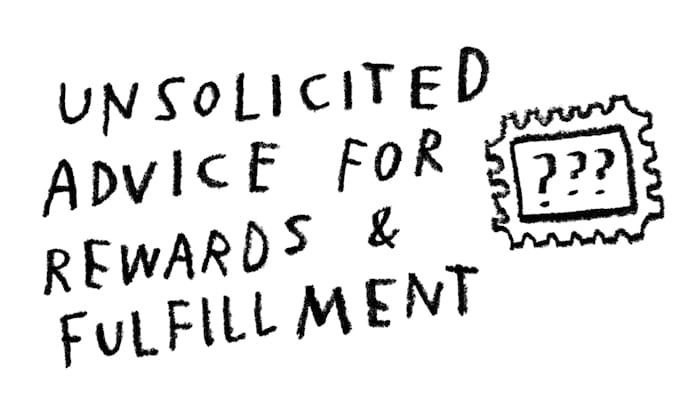Unsolicited Advice for Rewards and Fulfillment
My own experience has been a slow growth, handling larger volumes while also getting slowly better at packaging and streamlined shipping.

I spend a lot of time at the post office. In addition to my annual weekly planner project, which I pack and ship myself, I also operate a small online shop which has me dropping off mail several mornings per week. The Williamsburg, Brooklyn post office draws a unique crowd, ranging from parents with young children applying for passports, people moving to or from NYC with giant boxes of their possessions, the type of guy who obviously collects sneakers, and of course, young creative people (aka “people with visible tattoos”) who run online businesses.
In the years that I've been going to the post office I've struck up conversations with many people including small-scale publishers and other Kickstarter creators. While waiting in the lines, I’ve given directions, intervened in a screaming match and offered unsolicited advice to people I recognize as just starting out. My own experience has been a slow growth, handling larger volume while also getting slowly better at packaging and streamlined shipping. I’m just trying to spare others from making the mistakes I have.
Here's a (greatly expanded) version of some advice I recently offered to a young couple shipping out rewards on their first Kickstarter project.
1. Keep your rewards simple.
Besides the fact that tons of similar-but-different reward levels will confuse backers, it also means more work on your end as you prepare to ship. Focus on the product you want to create, whether it's a book, accessory, or anything else. Offer reward levels that build on each other in a way that makes sense, is clear, and drives backers to your product itself – not tangential stuff you'll have to spend extra money on.

2. There are a ton of variables when it comes to shipping and you’ll want to explore all of it while calculating your total project goal, as well as individual rewards.
Kickstarter allows you to add shipping cost by country and it's extremely important that you do this correctly. Use the postage calculator to make sure you get it right. Remember to weigh samples with the packaging it’ll go in, and round up. You are not able to make adjustments once your project is live and even one person has selected the reward, so get it right. Double check. I’m serious.
Media mail can be a tempting option, but it’s slower and somewhat limited. First Class Large Envelopes & Flats are cheaper than First Class Packages, but you’ll need to stay under 3/4 of an inch and technically these packages should not be lumpy (like pins or other small, but not flat, objects). This rate also does not include tracking. Some items are simply too heavy and must ship Priority Mail. Other times you know you’ll want the added speed and security of Priority Mail (which by default comes with $50 insurance).
International shipping brings its own challenges, and the USPS rates have increased every year for the last few years. This part is especially important to calculate properly in advance.
3. Don’t be cheap when it comes to secure, effective packaging.
There is nothing worse than having to send replacement rewards because something has gotten damaged in the mail. Don’t skimp when it comes to packaging – you should be thinking about this as you calculate your costs. How much extra per reward do you need to use appropriately padded envelopes, bubble wrap or boxes? Make sure delicate mail (records, books, ceramics, etc) are marked with DO NOT BEND or FRAGILE stickers.
4. Print postage online in advance so you can just drop off your mail.
If you show up to the post office with a ton of mail to be stamped, expect to be there forever. Spare yourself and the employees by taking care of postage at home, where you can listen to bad music and wear slippers if you want to.
USPS makes it (sort of) easy to pay for postage online with their Click-N-Ship service and you’ll also get the online postage discount, which does add up over time. Kickstarter allows you to export backer information in a number of spreadsheet formats which may help you work through all the labels you’ll need.
For larger projects or people who anticipate sending lots of mail, you can invest in a postage label printer. Here's a printer, iDPRT Thermal Label Printer SP410 Thermal Shipping Label Printer, 4x6 Label Printer, that will allow for printing a single label that serves as paid postage and an address label. When shipping internationally, the same size label also contains the customs information (no handwriting required for you and no re-entry for the postal employee). It uses thermal sticker labels, which means no actual ink.
There are other third-party shipping software companies that can help you import orders, send automatic shipment notice emails, purchase postage, and more. I personally use ShipStation which you can take a look at for larger-volume shipping.

5. If you’re printing postage and shipping in bulk, use the SCAN form.
If you’re dropping off bulk mail and it’s not being scanned in right away at the counter, print the SCAN form and have that scanned. It accounts for all of your mail for the day, and updates the tracking information from “Label Created” to “Accepted” right away. This also gives you some accountability if the postal service misplaces a package. Which they will.
6. Prepare for some annoying shit to happen because it’s gonna happen.
The postal service isn’t perfect. You aren’t perfect. The pile of mail at your recipient’s apartment building or doorstep or office isn’t perfect. Things break. Mail gets lost. Mail gets stolen. Keep in mind that you’ll need some extras, customers will have issues and you’ll be responsible even though you did everything write. Try to give yourself a buffer with your project so that these issues don’t completely derail things when they arise.
7. Keep records and receipts.
Depending on how much you raise on Kickstarter, you’ll be issued a 1099 form for tax reporting on the income. Make sure you’ll keeping track of all your expenses – postage, packaging and everything else – because you’ll want to write it all off. I don’t really know much about taxes but I do have a great accountant who is now very familiar with Kickstarter.
8. Have fun!
Congratulations, you’re a business. Isn’t it like, sooooo fun????

If you'd like more unsolicited advice on running a project from Adam, check out his recommendations for what to do during your launch week.

